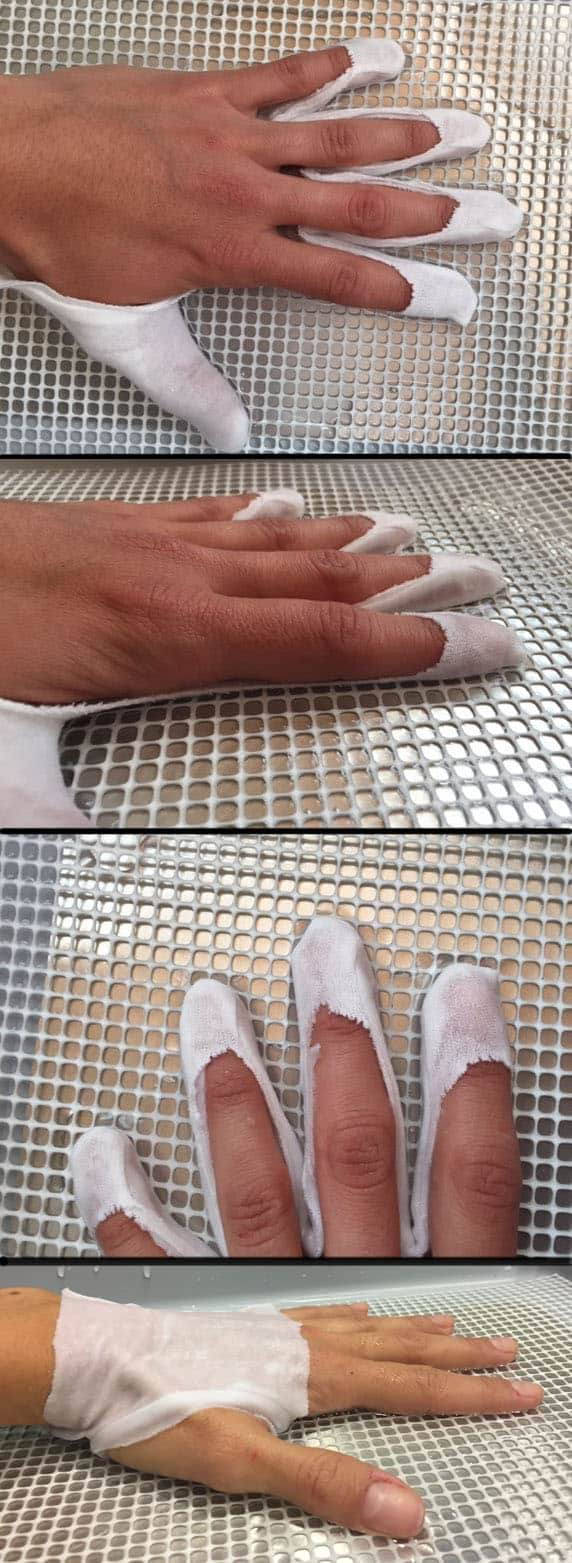How much water should I pour into the tubs?
Choosing the right water level
A sensible water height for the iontophoresis treatment
The following information applies to the treatment of hands and feet.
The basic knowledge: water conducts electricity!
No, we're not kidding!
The important thing is to make the water reach those parts of your body you want to be affected by the therapy. This rule always applies, no matter what and where you treat.
Avoiding beginner's mistakes: pain & skin irritations are alarm signals
Your skin must always be intact before, during, and after the iontophoresis therapy.
Should you notice skin irritations or "burns" in the worst case, this is a sign that your treatment current was too powerful!
By hurting your skin, you are negatively affecting the therapy.
If this happened to you, it's time to take breaks until your skin is in great shape again.
If a user is cauterized or burned during the treatment, they will usually notice a short-term sudden increase in the current sensation. In this case, the condition of the skin must be checked immediately.
Certain iontophoresis users don't perceive the treatment current due to a strongly reduced sensitivity in the area of the current flow (e.g. polyneuropathy).
For this reason, you should always increase the current very carefully and check your skin after a short treatment time, especially if you are new to the therapy.
Even if you are an experienced user, it is always best to proceed in the same cautious way. After a change of treatment parameters, you should check the condition of your skin a short time (1-2 minutes) after having reached the desired current intensity.
- Pain in defined areas - pain at the waterline: it makes sense to select the water level in such a manner that the water does not reach the areas that are affected by the pain.
- If the entire iontophoresis treatment hurts (e.g. the whole hand/foot hurts), the current is definitely too high. You should feel a slight tingling sensation at most. Lower the current until you don't feel any current sensation whatsoever - now, the current strength is just right.
Level and width of the effect of iontophoresis
Width refers to the iontophoresis effect on the surface of the contact electrodes. Obviously, when you are performing your therapy with smaller electrodes in sponge material, cloths, pockets, bags, fabrics, or other special electrodes, you don't have a conventional waterline during your treatment. However, the basic principle remains the same: iontophoresis usually takes an effect even beyond the scope of the electrodes.
Since the effect of iontophoresis usually goes above the waterline, it makes sense to focus first on the treatment of the soles or the palms. Once they are dry, you can see whether the treatment has an effect on the areas above the waterline. If need be, you can conduct further treatments with a higher waterline to tackle any areas that might still be sweating.
IMPORTANT: As a rule, the level of the iontophoresis effect can be described in the following manner (individual deviations may occur): water level in the tubs plus ~ 1 cm.
The width of the effect usually goes far beyond the edges of the cloths or sponges covering the skin.
Conclusion: In general, the width of the treatment affects larger areas than the height.
Tip: If it can be done, treat the sweating areas individually or separately.
It makes sense to adjust the water line by twice its height after you have tested its most effective height. Let us say that the iontophoresis effect works 2 cm above the water line in this case.
As a rule, a water height between a few millimetres and half a centimetre is sufficient, as long as the electrodes and the grids (for Hidrex and Idromed devices) are well covered by the water in the tubs. You will have 1-3 millimetres of water above the grids for your iontophoresis treatment.
Many users prefer the following method for its efficiency and time-saving skills: At first, treat "ONLY" the soles or palms.
The water height can be set to the lowest level (Idromed and Hidrex: 1-3 mm above the grids).
If you still sweat on the sides of your hands or feet after having treated the soles/palms, you can readjust the water height accordingly and thus reach the perfect setting.
If you cannot get all areas dry at the same time by using just one water level, you can simply conduct treatments with different water levels: simply add more water to the tubs after a certain therapy time.
In this way, the treatment of hands or feet is adjusted optimally for most cases. The effect generally works even on areas that are above the water line.
When using towels as electrode covers, as used to be the case with Hidrex machines, you can simply soak the towels until they are dripping wet without adding additional water to the tubs.
IMPORTANT - please keep the following in mind as you read through this article:
Most users need the strongest effect on their soles or their palms, which is where the skin is at its thickest.
If you fill too much water into the tubs, most of the current flows through the thinner skin on the side of the feet or the hands and does not work on the thicker-skinned areas.
Because of the excess of current working on the thin-skinned areas, the skin usually becomes irritated - you can observe this in the state of the skin along the water line.
Therefore, if you sweat only on the soles of your feet, it makes little sense to fill the water all the way up to your ankles.
On the contrary, this is likely to be a disadvantage, since the skin on the soles is much thicker than the instep or the ankle.
The current always seeks the path of the least resistance. It passes mainly through areas that do not tend to sweat and therefore does not achieve any effect. The effect on the soles then falls away due to the lack of electricity.
An additional problem is that you can no longer increase the current to an appropriate value, since the skin on the side of the foot is thinner and therefore more sensitive to the current.
In summary, using too much water is disadvantageous in two ways: the current is set to a lower value, and areas that are not affected by sweating soak up almost all of the current. The therapy time is wasted.
This is probably one of the biggest mistakes an iontophoresis user can make, and the main reason the therapy might not work, take too long, or be conducted inefficiently.
Side effects are unavoidable: if the water level is suboptimal, the thinner-skinned areas will usually suffer, since the current flows through them very strongly.
Injuries to the nail bed are another reason not to use too much water. Any injuries will have a lower current resistance than healthy skin. A disproportionate amount of electricity may pass through them. Hobby electricians will be familiar with the term "voltage divider" - this is exactly the effect that takes place.
Of course, this reduces your chances of achieving an optimal result considerably. In addition, there is the danger of injuring yourself further due to the current flow.
If you sweat partially on the back of your hands or feet, you can perform the treatment with a low water level and a wet washcloth (undyed cotton or linen only) draped over this area.
In this manner, you can avoid irritating the skin along the waterline. If you sweat all the way up to your ankles, you can wear tennis socks during the treatment instead of filling the tubs all the way to the brim.
For the hands, cotton gloves from the hardware store will do just fine.

Should you notice that you are not having any success with only one water level, it is usually necessary to address all sweating areas separately and in a well-defined way.
In practice, such a treatment can look as follows:
If your entire hand is affected by sweat, it makes perfect sense to dry the palms first and the back of your hand in a separate treatment.
In many cases, it's simply impossible to get all areas dry at the same time, unless you sweat only on the palms/soles and just above the water line, where the iontophoresis effect can still reach the skin.
If your feet sweat all the way up to the ankle except for the back of the foot, just cut off the tennis socks below the ankle and cut out the area that would cover the back of the feet.
Alternatively, use a lotion or a tape to "isolate" parts of the skin from the current.
Should the current density no longer suffice for the soles/palms, individual areas can be treated separately once more.
Example: a user sweats on the soles and the backs of the feet.
They could treat their feet for 15 minutes with a low water level (water just above the grid) for the soles. Then, they could treat the back of their feet with cut-out tennis socks or a washcloth/piece of fabric for 10 minutes.
Hopefully, this article has given you a good overview of the methods for adjusting individual water levels.
If you have any questions, please email us. We will be happy to answer.
